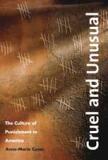Where Does It End?
This is a book about police, television and God. It argues that punishment has changed in the past 35 years. Penalties are harsher, sentences longer, prisons more crowded. The United States, home to 5 percent of the world’s population, houses 25 percent of the world’s prisoners—the highest rate in the world. Seven million Americans are either in prison or on parole (most of them for nonviolent crimes). Only 19 percent of all crimes involve violence.
Anne-Marie Cusac, a professor in the Department of Communication at Roosevelt University, in Schaumburg, Ill., posits a continuum between changing attitudes toward the punishment of prisoners and other issues, like corporal punishment of children. She also correlates theories of punishment to ideas about what humans are—whether they are essentially good, evil or something in between.
Some chapters review the severity of early punishments in colonial times. In the 19th century Benjamin Rush and the Quakers tried to reform the American punitive system. Rush opposed corporal punishment for children, all public floggings and capital punishment. He argued they tended to “de-sensitize” people. For Rush, the human heart is never wholly corrupt. He worked for what became the American “penitentiary” system. Solitary confinement, silence and work were designed to lead to reform of the prisoners. Often enough, though, they generated madness.
In one of her constant indictments of religion, Cusac argues: “Physical punishments of the sort that involve intentional pain tend to have religious sources.... Punishments that focus on individual liberty (or lack of it) and internal transformation, in contrast, have their source in the Enlightenment and liberal religious philosophy.” Cusac is persuasive in showing that throughout American history, punishment methods have never stayed put in the places with which we generally associate them—in cells with criminals. Cusac claims there has been a kind of “punishment creep.” She notes that restraining devices designed for prisons (e.g., restraint chairs, taser guns) are more and more employed in schools.
To be sure, my hair stood on edge when I read Cusac’s accounts of right-wing religious groups championing “holy hitting” of willful children (to beat the devil out of them) and the link between strong support for physical chastisement of children and other cruel punishments, such as the death penalty or the new panoply of sophisticated, often cruel and dangerous, electronic restraining devices like stun belts or stun guns. In a somewhat lurid chapter, entitled “Flogging for Jesus,” Cusac recounts children’s deaths and serious injuries as a result of these disciplinary practices. Actually, she makes more of this right-wing Christian corporal punishment than I consider justified, drawing a parallel to America’s current mania for cruel and unusual punishments, even for child perpetrators of violent crimes.
In the 19th and early 20th century, progressive reformers believed in the rehabilitation of criminals. They linked crime to malevolent environments of poverty. Such reformers invented probation, parole and the indeterminate sentence. They championed the separation of juvenile offenders. Sometime in the mid 1970s, however, the idea that prisoners are capable of rehabilitation came to be rejected. Rehabilitation ceased to be one of the explicit goals of the prison system.
In an intriguing chapter on popular culture, Cusac shows how much television and newspapers exaggerate crime. Police dramas over-emphasize successful arrest rates and violent crimes. They instill fear of criminals as somehow being intractable and endowed with congenital “criminal minds.” She notes how in the period from 1993 to 1996, when the nation’s murder rate declined 20 percent, the number of murder stories reported on prime time news shows on ABC, NBC and CBS rose by 721 percent!
Readers may find difficult to digest the author’s claim that the myriad cop shows on television are secretly following a Christian narrative, representing a “pollution and purification” ritual. “The idea that Christianity is punitive and it is this characteristic—more than forgiveness and love—that marks this dominant genre of American television is not likely to be a popular idea among Christians who prefer their religion in its more kindly forms. It might also come as an unpleasant surprise to non-Christian fans of cop shows.” As if secularists are all imbued with Enlightenment philosophy or incapable of championing torture or cruel punishment on their own, without some secret recourse to a crypto-Christian code of vengeance!
In places, Cusac knows better. She acknowledges that Quakers, Sister Helen Prejean, C.S.J., Unitarians and Chuck Colson’s evangelical Prison Fellowship have worked for more humane punishment. But she is intent on showing a pernicious Christian cultural code, impervious to reason, that lies deep in the American psyche about punishment. Sociologists like me would demand more concrete survey data about attitudes concerning punishment and be less open to the kind of anecdotal evidence and rhetorical analysis that drives Cusac’s book. It is too bad that such an otherwise intriguing book is marred by this idée fixe.
I recommend her final chapters on how some United States jails anticipated Abu Ghraib (in the use of dogs, forcing prisoners to wear women’s underwear, creating circumstances in which they soil themselves and the resort to hoods and electric wires for restraint). Without question, American punishment has become quite cruel and unusual. But I doubt that its provenance can be so singly traced to underlying religious beliefs.
This article also appeared in print, under the headline “Where Does It End?,” in the May 4, 2009, issue.








